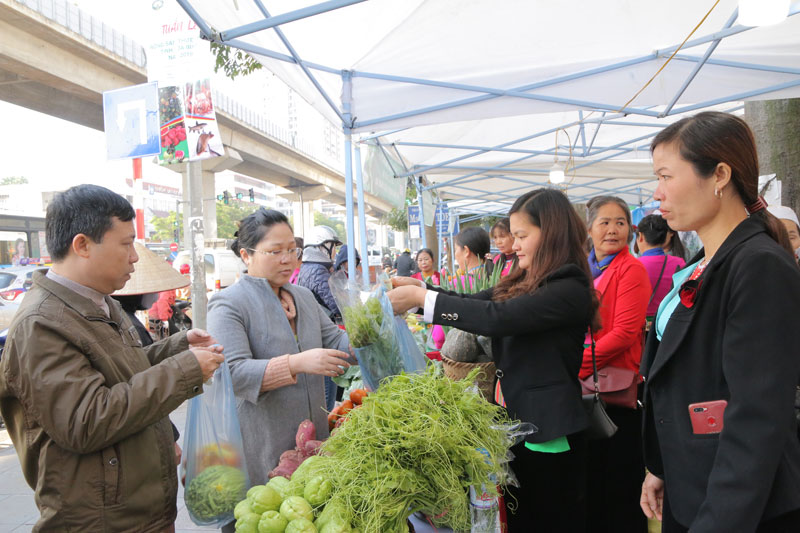
(HBO) - In 2019, districts and cities completed the evaluation and grading of the One Commune Once Product (OCOP) programme at the district level for 50 products.
 Hanoi consumers are choosing safe vegetable products of the Quyet Chien safe vegetable production cooperative in Tan Lac district.
Hanoi consumers are choosing safe vegetable products of the Quyet Chien safe vegetable production cooperative in Tan Lac district.
As a result, 37 products (obtaining 50 points and above) have been submitted by the People's Committees of districts and cities for the evaluation and ranking at the provincial-level.
By the end of 2019, the province had nine products rated four stars and 18 others rated three stars.
After one year of the implementation, the programme has recorded positive results. The number of cooperatives has rapidly increased, especially production cooperatives in rural areas. Innovation and start-up movements in agriculture production in rural areas have been promoted.
Agricultural products have been diversified, initially becoming commodities. Some branded products and those with geographical indication (GI) are popular to consumers in and outside the province.
In recent times, many conferences have been organised to promote consumption of OCOP products, significantly contributing to improving the value of agriculture production.
Memoranda of understanding on cooperation were signed between distributors and supermarket systems with local farmers and cooperatives, aiming to provide OCOP products in distribution systems nationwide.
Connection between local cooperatives and enterprises has helped promote production and business of traditional products and services of Hoa Binh, and improve the competitiveness of local products in domestic and foreign markets.
Vice Chairman of the provincial People’s Committee Nguyen Van Dung said through the OCOP programme, the locality’s agriculture sector has been promoted.
Local farmers have been encouraged to change the structure of plants, select suitable plant varieties, expand cultivation areas, increase productivity and improve the quality of their products, and form concentrated commodity production areas.
To expand markets for OCOP products, specialties and potential products of Hoa Binh, in the coming time, the province will enhance communication campaigns and focus on building brands for products and developing trade villages.
Conferences to connect local farmers with businesses continue to be organised, thus further promoting sales of OCOP products in distribution systems across the country./.
According to data from the Hoa Binh Provincial Party Committee, the industrial production index for the first six months of 2025 is estimated to have increased by 20% compared to the same period last year. This marks the highest year-on-year growth rate for this period since 2020.
In the first six months of 2025, Hoa Binh province’s export turnover was estimated at 1.145 billion USD, marking an 18.11% increase compared to the same period in 2024. Import turnover was estimated at $ 804 million, a 17.15% increase, which helped the province maintain a positive trade balance.
The lives of the ethnic minority farmers in Tan Lac district have gradually improved thanks to the new directions in agricultural production. This is a testament to the collective strength fostered through the professional associations and groups implemented by various levels of the district’s Farmers’ Union.
With the motto the "product quality comes first,” after nearly one year of establishment and operation, Muong village’s Clean Food Agricultural and Commercial Cooperative, located in Cau Hamlet, Hung Son Commune (Kim Boi district), has launched reputable, high-quality agricultural products to the market that are well-received by consumers. The products such as Muong village’s pork sausage, salt-cured chicken, and salt-cured pork hocks have gradually carved out a place in the market and they are on the path to obtaining the OCOP certification.
In the past, the phrase "bumper harvest, rock-bottom prices" was a familiar refrain for Vietnamese farmers engaged in fragmented, small-scale agriculture. But today, a new spirit is emerging across rural areas of Hoa Binh province - one of collaboration, organisation, and collective economic models that provide a stable foundation for production.
Maintaining growing area codes and packing facility codes in accordance with regulations is a mandatory requirement for agricultural products to be eligible for export. Recently, the Department of Agriculture and Environment of Hoa Binh province has intensified technical supervision of designated farming areas and packing facilities to safeguard the "green passport" that enables its products to access international markets.



 Hanoi consumers are choosing safe vegetable products of the Quyet Chien safe vegetable production cooperative in Tan Lac district.
Hanoi consumers are choosing safe vegetable products of the Quyet Chien safe vegetable production cooperative in Tan Lac district.